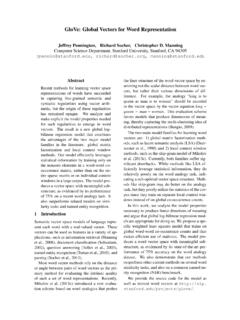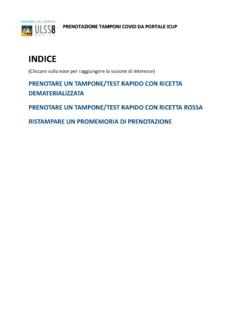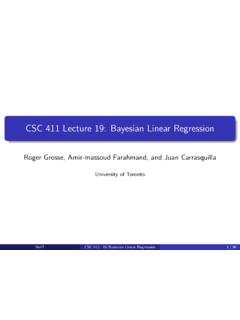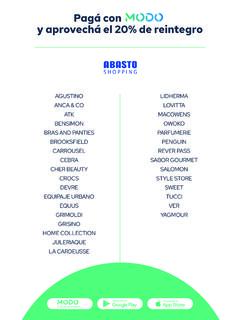Transcription of SuperGLUE: A Stickier Benchmark for General-Purpose ...
1 superglue : A Stickier Benchmark forGeneral-Purpose Language Understanding SystemsAlex Wang New York UniversityYada Pruksachatkun New York UniversityNikita Nangia New York UniversityAmanpreet Singh Facebook AI ResearchJulian MichaelUniversity of WashingtonFelix HillDeepMindOmer LevyFacebook AI ResearchSamuel R. BowmanNew York UniversityAbstractIn the last year, new models and methods for pretraining and transfer learning havedriven striking performance improvements across a range of language understand-ing tasks. The GLUE Benchmark , introduced a little over one year ago, offersa single-number metric that summarizes progress on a diverse set of such tasks,but performance on the Benchmark has recently surpassed the level of non-experthumans, suggesting limited headroom for further research.
2 In this paper we presentSuperGLUE, a new Benchmark styled after GLUE with a new set of more diffi-cult language understanding tasks, a software toolkit, and a public is available IntroductionIn the past year, there has been notable progress across many natural language processing (NLP)tasks, led by methods such as ELMo (Peters et al., 2018), OpenAI GPT (Radford et al., 2018),and BERT (Devlin et al., 2019). The common thread connecting these methods is that they coupleself-supervised learning from massive unlabelled text corpora with a recipe for effectively adaptingthe resulting model to target tasks. The tasks that have proven amenable to this general approachinclude question answering, sentiment analysis, textual entailment, and parsing, among many others(Devlin et al.)
3 , 2019; Kitaev and Klein, 2018, ).In this context, the GLUE Benchmark (Wang et al., 2019a) has become a prominent evaluationframework for research towards General-Purpose language understanding technologies. GLUE isa collection of nine language understanding tasks built on existing public datasets, together withprivate test data, an evaluation server, a single-number target metric, and an accompanying expert-constructed diagnostic set. GLUE was designed to provide a General-Purpose evaluation of languageunderstanding that covers a range of training data volumes, task genres, and task formulations. Webelieve it was these aspects that made GLUE particularly appropriate for exhibiting the transfer-learning potential of approaches like OpenAI GPT and progress of the last twelve months has eroded headroom on the GLUE Benchmark some tasks (Figure 1) and some linguistic phenomena (Figure 2 in Appendix B) measuredin GLUE remain difficult, the current state of the art GLUE Score as of early July 2019 ( fromYang et al.
4 , 2019) surpasses human performance ( from Nangia and Bowman, 2019) by Equal contribution. Conference on Neural Information Processing Systems (NeurIPS 2019), Vancouver, +ELMo+AttnOpenAI GPTBERT + Single-task AdaptersBERT (Large)BERT on STILTsBERT + BAMSemBERTS norkel MeTaLALICE (Large)MT-DNN (ensemble)XLNet-Large (ensemble) ScoreHuman PerformanceCoLASST-2 MRPCSTS-BQQPMNLIQNLIRTEWNLIF igure 1: GLUE Benchmark performance for submitted systems, rescaled to set human performanceto , shown as a single number score, and broken down into the nine constituent task tasks with multiple metrics, we use an average of the metrics. More information on the tasksincluded in GLUE can be found in Wang et al. (2019a) and in Warstadt et al. (2018, CoLA), Socheret al. (2013, SST-2), Dolan and Brockett (2005, MRPC), Cer et al.
5 (2017, STS-B), and Williams et al.(2018, MNLI), and Rajpurkar et al. (2016, the original data source for QNLI).points, and in fact exceeds this human performance estimate on four tasks. Consequently, while thereremains substantial scope for improvement towards GLUE s high-level goals, the original version ofthe Benchmark is no longer a suitable metric for quantifying such response, we introduce superglue , a new Benchmark designed to pose a more rigorous test oflanguage understanding. superglue has the same high-level motivation as GLUE: to provide asimple, hard-to-game measure of progress toward General-Purpose language understanding technolo-gies for English. We anticipate that significant progress on superglue should require substantiveinnovations in a number of core areas of machine learning, including sample-efficient, transfer,multitask, and unsupervised or self-supervised follows the basic design of GLUE: It consists of a public leaderboard built aroundeight language understanding tasks, drawing on existing data, accompanied by a single-numberperformance metric, and an analysis toolkit.
6 However, it improves upon GLUE in several ways: More challenging tasks: superglue retains the two hardest tasks in GLUE. The remain-ing tasks were identified from those submitted to an open call for task proposals and wereselected based on difficulty for current NLP approaches. More diverse task formats:The task formats in GLUE are limited to sentence- andsentence-pair classification. We expand the set of task formats in superglue to includecoreference resolution and question answering (QA). Comprehensive human baselines:We include human performance estimates for all bench-mark tasks, which verify that substantial headroom exists between a strong BERT-basedbaseline and human performance. Improved code support: superglue is distributed with a new, modular toolkit for workon pretraining, multi-task learning, and transfer learning in NLP, built around standard toolsincluding PyTorch (Paszke et al.)
7 , 2017) and AllenNLP (Gardner et al., 2017). Refined usage rules:The conditions for inclusion on the superglue leaderboard havebeen revamped to ensure fair competition, an informative leaderboard, and full creditassignment to data and task superglue leaderboard, data, and software tools are available Related WorkMuch work prior to GLUE demonstrated that training neural models with large amounts of availablesupervision can produce representations that effectively transfer to a broad range of NLP tasks(Collobert and Weston, 2008; Dai and Le, 2015; Kiros et al., 2015; Hill et al., 2016; Conneau andKiela, 2018; McCann et al., 2017; Peters et al., 2018). GLUE was presented as a formal challengeaffording straightforward comparison between such task-agnostic transfer learning techniques.
8 Othersimilarly-motivated benchmarks include SentEval (Conneau and Kiela, 2018), which specificallyevaluates fixed-size sentence embeddings, and DecaNLP (McCann et al., 2018), which recasts a setof target tasks into a general question-answering format and prohibits task-specific parameters. Incontrast, GLUE provides a lightweight classification API and no restrictions on model architecture orparameter sharing, which seems to have been well-suited to recent work in this its release, GLUE has been used as a testbed and showcase by the developers of severalinfluential models, including GPT (Radford et al., 2018) and BERT (Devlin et al., 2019). As shownin Figure 1, progress on GLUE since its release has been striking. On GLUE, GPT and BERT achieved scores of and respectively, relative to for an ELMo-based model (Peterset al.)
9 , 2018) and for the strongest baseline with no multitask learning or pretraining above theword level. Recent models (Liu et al., 2019d; Yang et al., 2019) have clearly surpassed estimates ofnon-expert human performance on GLUE (Nangia and Bowman, 2019). The success of these modelson GLUE has been driven by ever-increasing model capacity, compute power, and data quantity, aswell as innovations in model expressivity (from recurrent to bidirectional recurrent to multi-headedtransformer encoders) and degree of contextualization (from learning representation of words inisolation to using uni-directional contexts and ultimately to leveraging bidirectional contexts).In parallel to work scaling up pretrained models, several studies have focused on complementarymethods for augmenting performance of pretrained models.
10 Phang et al. (2018) show that BERT canbe improved using two-stage pretraining, , fine-tuning the pretrained model on an intermediatedata-rich supervised task before fine-tuning it again on a data-poor target task. Liu et al. (2019d,c) andBach et al. (2018) get further improvements respectively via multi-task finetuning and using massiveamounts of weak supervision. Anonymous (2018) demonstrate that knowledge distillation (Hintonet al., 2015; Furlanello et al., 2018) can lead to student networks that outperform their , the quantity and quality of research contributions aimed at the challenges posed by GLUE underline the utility of this style of Benchmark for machine learning researchers looking to evaluatenew application-agnostic methods on language to current approaches are also apparent via the GLUE suite.







